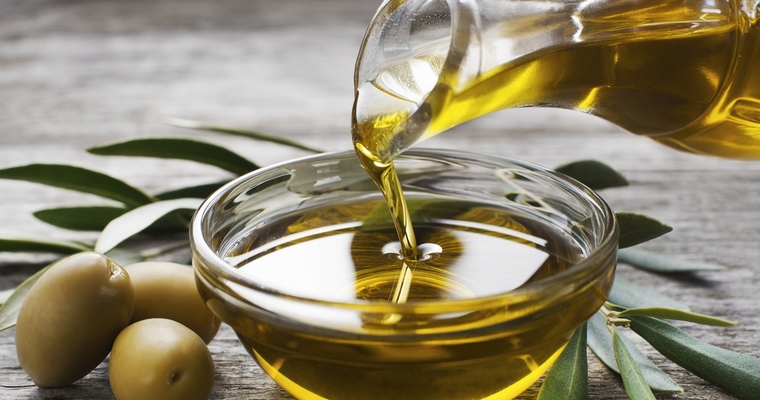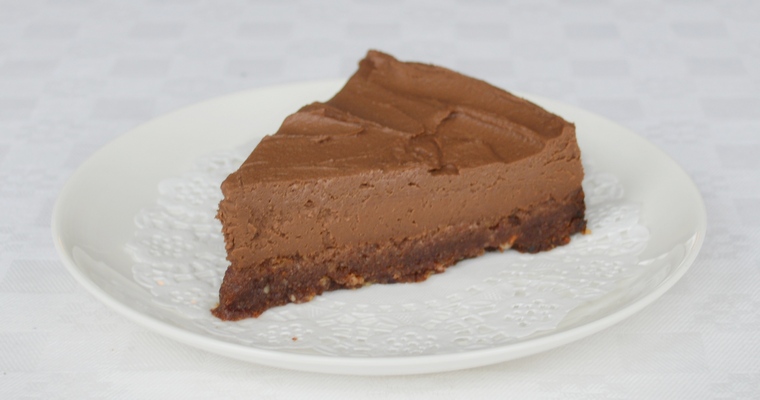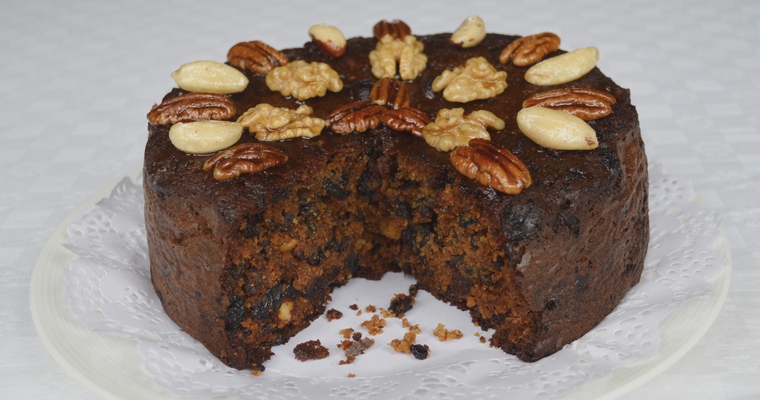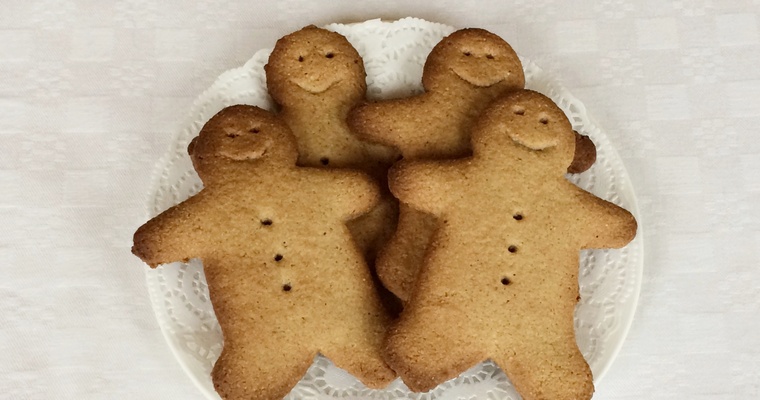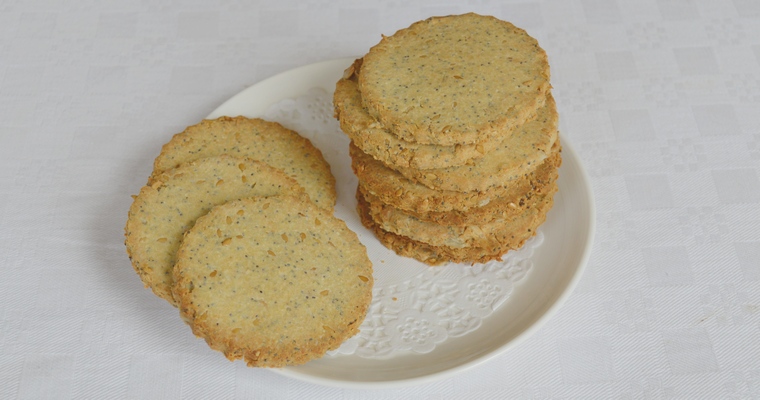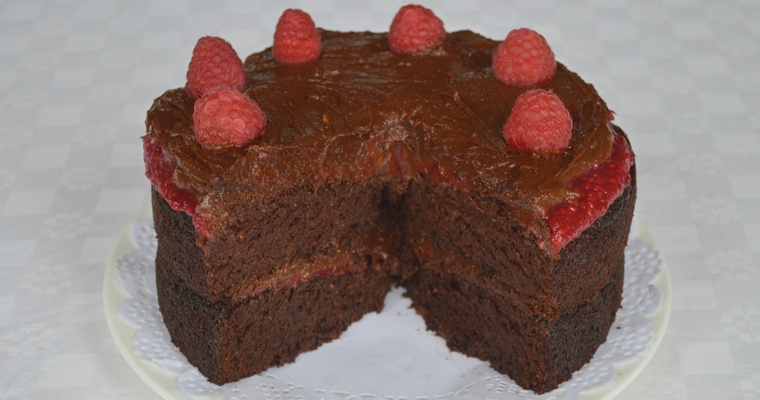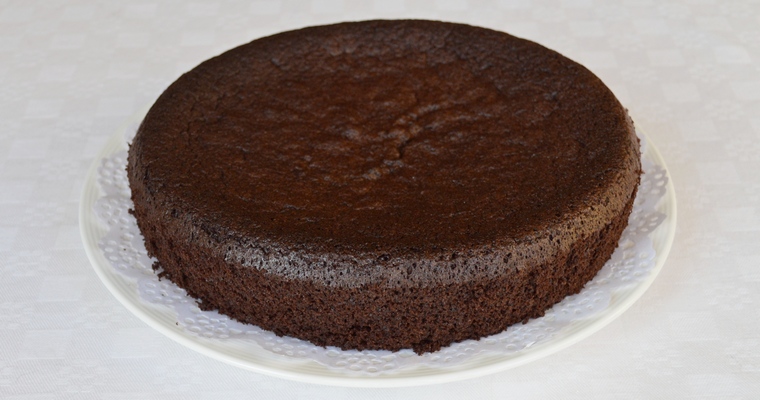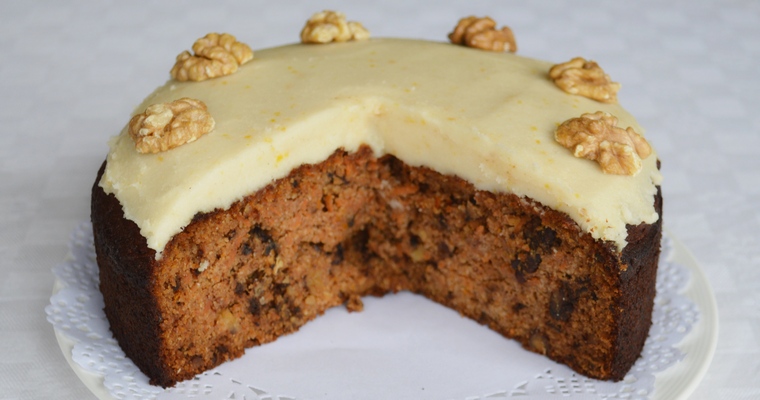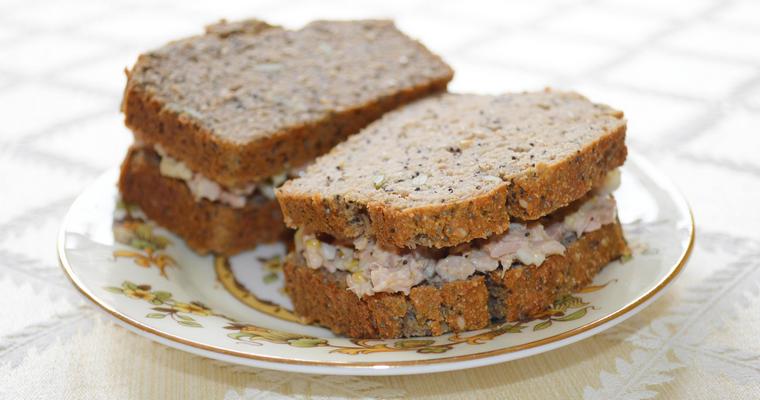Guide to replacing butter with olive oil for delicious dairy-free cakes and biscuits. Includes a conversion table, and instructions for adapting recipes.
Technique
01. What is the role of butter in a baking recipe?
02. Why are solid fats preferred for baking?
03. What different types of fat can be used for baking?
04. Why replace butter?
05. Why use olive oil for baking?
06. What’s the difference between ‘Extra Virgin’ and ‘Light’ olive oil?
07. How will olive oil affect the flavour?
08. How will olive oil affect the structure and texture?
09. What happens if I replace butter one-for-one with olive oil?
10. How do I convert an amount of butter to olive oil?
11. What adjustments will I need to make to the recipe?
Recipes
12. Which recipes work best with olive oil?
01. What is the role of butter in a baking recipe?
Butter acts as a lubricant in baking recipes, melting when heated. This weakens the structure of bakes by preventing the sticky, structural elements like gluten and egg proteins from bonding together. In cakes, this results in a soft crumb that crumbles when sliced. In pastry, this results in a flaky crust that falls apart. This lubricating effect also enhances the eating experience, creating a sensation of moistness in the mouth.
Properties of butter:
- Hydration: butter comprises 20% water and 80% fat. Unlike water, fat does not evaporate or become absorbed during heating. Instead, fat melts into the batter to lubricate the flour. This creates a moist bake.
- Texture: butter helps bakes to rise by trapping air, and by releasing steam as the water content evaporates. This creates a light and fluffy texture. Butter can be creamed with granulated sugar to create tiny pockets of air in the batter during the mixing stage (mechanical aeration). During the heating stage it melts, creating a channel for the bubbles of carbon dioxide that are produced by raising agents like baking soda (chemical aeration).
- Structure: butter reduces gluten formation and egg protein coagulation (it coats flour particles in an oily film, and it competes with eggs proteins to bond to other egg proteins). This weakens the structure, creating a tender crumb that is crumbly without being dry.
- Flavour: butter has a pleasant flavour and a rich mouthfeel. It has a low melting point, which means that it melts in the mouth. This creates a bake that feels moist without being greasy.
- Crust: butter promotes the formation of a flavoursome brown crust, as milk solids contain sugar and protein. When heated, sugars and proteins undergo chemical reactions that create deeper flavours and colours (caramelisation and the Maillard reaction). Browning can only happen once all the water has been driven out and the surface temperate can exceed 100°C/210°F. Fat helps to raise the temperature by acting as a heat transfer agent.
02. Why are solid fats preferred for baking?
Fats are classified according to whether they are solid at room temperature or liquid. Liquid fats are less versatile to bake with because they have a weakening effect on the structure. Oils cannot be creamed with sugar to create aerated batters, nor can they be rubbed into flour to create flaky pastry dough. Instead, they must be stirred directly into the dry ingredients. This results in a dense structure and moist texture. If the oil is not thoroughly incorporated during the mixing stage, then the finished bake can be unpleasantly greasy. Egg yolks, honey and xanthum gum are all emulsifiers that help to suspend the oil particles in the batter to prevent greasiness.
(butter, coconut oil, lard, suet)
- solid at room temperature
- range from white to pale yellow in colour
- neutral flavours
- higher melting points
- stable when heated
- best stored in the fridge
- light, delicate sponge cakes
- cake frosting / fillings
- pie crusts
- pastry
- steamed puddings
Good for light and fluffy cakes like a Victoria sponge, as solid fats can be creamed with granulated sugar to trap air. Butter is also creamed with powdered sugar to create a thick paste that can be sandwiched in the middle of cakes and muffins (buttercream).
Lard and butter may be rubbed into flour to make biscuits, pie crusts and pastry. The rubbing actions coats the flour particles in an oily film, creating a crumbly texture that falls apart.
Suet has a particularly high melting point, which adds lightness to steamed puddings. By the time it melts, the batter has had time to set around the suet lumps, leaving behind a regular network of air bubbles.
Biscuits made with butter and coconut oil tend be thin and crisp, as these fats have lower melting points. This causes doughs to spread more in the oven before they set.
(olive oil, nut oils, seed oils, vegetable oils)
- liquid at room temperature
- range from light gold to amber to pale green in colour
- distinctive flavours
- lower melting points
- prone to becoming oxidised or rancid when heated
- best stored in a cool, dark cupboard
- moist, dense cakes
- strongly flavoured bakes
- soft, chewy cookies
Good for bakes which require moistness, like banana bread. Also good for bakes with strong flavours like gingerbread cake. The distinctive flavours of plant-based oils need to be balanced with other strong flavours to avoid overwhelming.
Liquid fats cannot be creamed with sugar. Instead, batters are prepared using the all-in-one method, where all the ingredients are mixed together at the same time. Bakes will have a flatter, denser structure, and require a chemical raising agent like baking soda.
Biscuits hold their original shape and do not spread much in the oven, since the fat was already a liquid when the raw dough was formed.
03. What different types of fat can be used for baking?
Whether a fat is a solid or a liquid is determined by its chemical structure. Fats are made up of long chains of carbon atoms, linked together by single bonds (C-C) or double bonds (C=C). Double bonds can split apart and react with hydrogen, so that one bond continues to link across to the next carbon atom in the chain, while the other bond links up to an isolated hydrogen atom. In saturated chains, every double bond in the chain has split apart and bonded to a hydrogen atom. When a chain holds as many hydrogen atoms as possible, it is described as ‘saturated’. This creates a stronger, denser structure, as double bonds introduce a kink to the chain, forcing the carbon atoms further apart. Fats chains that only have one double bond are described as ‘monounsaturated’ (mono- meaning one), while fat chains that have more than one double bond are described as ‘polyunsaturated’ (poly- meaning many). The more double bonds there are, the less stable the fat. Fats that are high in polyunsaturated fat should never be heated, as they are highly reactive. When heated, they form toxic, cancer-causing chemical compounds.
04. Why replace butter?
Cow’s milk is a sweet-tasting liquid that is churned and fermented to produce butter, cheese and yoghurt. The sweetness comes from a sugar called lactose. Lactose is a disaccharide, which means that it is formed from two carbohydrates bonded together (di- meaning two, and -saccharide meaning sugar). This complex molecular structure makes it difficult to digest. Over time, a diet that is high in complex carbohydrates can place an intolerable strain on the small intestine, leading to painful bloating, cramping and diarrhoea. Some people cannot digest milk at all because they do not have the necessary digestive enzymes. This is what is meant by lactose intolerance. Nearly 70% of the world’s population lacks lactase, the enzyme that breaks down milk. It is an evolutionary quirk that the peoples of northern Europe predominantly maintain lactase production into adulthood, while most other ethnic groups cease production after weaning.
05. Why use olive oil for baking?
Olives have been cultivated to produce oil for thousands of years along the Mediterranean coast. Olive-producing countries like Spain, Portugal, Italy and Greece cook with olive oil rather than animal fat. The hot climate and irregular rainfall is not conducive to producing the rich pasture land that is needed for raising cattle. As a result, there is a long tradition of making breads, cakes and biscuits with olive oil rather than butter. Olive oil cakes also keep better, retaining a moist crumb for several days. In contrast, cakes made with butter need to be eaten within a day or two of baking before they go stale.
06. What’s the difference between ‘Extra Virgin’ and ‘Light’ olive oil??
Olive oil is made by crushing olives to separate the oil from the paste. The leftover paste is then processed again, repeatedly, in order to extract more oil. Each extraction diminishes the flavour, colour and nutritional profile of the oil. Like wine, olive oil is graded according to quality. The highest-quality oil is labelled ‘cold-pressed Extra Virgin Olive Oil’. This refers to the fact that it was produced from the first press, using only a mill. Subsequent extractions rely on heat and chemical solvents to extract diminishing levels of oil from the paste. This low-quality oil is labelled ‘Light Olive Oil’, which refers to the colour and flavour.
07. How will olive oil affect the flavour?
Olive oil is not a uniform ingredient. The flavour may be grassy, peppery, buttery, fruity, citrus or nutty. Flavour is influenced by many factors, including the variety, climate, soil, ripeness at harvest and the extraction method. Extra virgin olive oil is usually reserved for drizzling over finished dishes, since heating destroys the flavour. Light olive oil has already been heated, which means that most of the flavour and pungency has been removed. This makes it more suitable for high temperature cooking like frying, roasting and baking. It also costs a fraction of the price. Some olive oil cakes do use extra virgin olive oil, but the assertive flavour is generally balanced with other strong flavours, such as aromatic spices, essences, chocolate, dried fruits, nuts or citrus. If you stick to light olive oil for baking, then the mild flavour will not affect the overall taste (just like vegetable oil). If, for health reasons, you prefer to use extra virgin olive oil, then pick one that has a buttery flavour and is not bitter.
08. How will olive oil affect the structure and texture?
Bakes made with olive oil will be crumblier and have a softer crumb. This is because olive oil inhibits the formation of a sticky protein called gluten. Wheat flour produces gluten when it is mixed with water. Unlike butter, which is 20% water, olive oil is 100% fat, which means that less water is available for the development of gluten. Cakes will also be denser, since liquid fats cannot be creamed with granulated sugar to trap air. Egg white foam and chemical raising agents like baking soda may be added for aeration, but it is hard to reproduce the light and fluffy texture of butter cakes. Pie crusts and flaky pastry are impossible to reproduce, since they are reliant on using a cold, solid fat to create a stiff dough that can be manipulated into shape. Biscuits will be soft and chewy, with a crisp exterior but a cake-like interior.
09. What happens if I replace butter one-for-one with olive oil?
Olive oil does not offer a seamless replace for butter, as it has a different flavour, lower water content and is liquid at room temperature. This means that you cannot simple replace 225g of butter with olive oil in a recipe and achieve comparable results. Bakes made with olive oil will be denser, moister, chewier and crumblier.
10. How do I convert an amount of butter to olive oil?
You do not need to use as much olive oil to get the same fat content as butter, since butter comprises 20% water. If you are measuring by weight (grams), simply reduce the amount of olive oil by 20% when measuring it out into millimetres. However, if you are measuring by volume (cups), you need to reduce the amount of olive oil by 25%. This is because the water content in butter makes it denser than olive oil. Water molecules have positive and negative ends that are attracted to one another, and therefore pack closer together than fat molecules. This means that 1 cup of butter weighs slightly more than 1 cup of olive oil (225g versus 210g).
Weight (UK grams)
| Butter | Olive Oil |
|---|---|
| 50g | 40ml (35g) |
| 75g | 60ml (55g) |
| 100g | 80ml (75g) |
| 125g | 100ml (90g) |
| 150g | 120ml (105g) |
| 175g | 140ml (125g) |
| 200g | 160ml (140g) |
| 225g | 180ml (160g) |
Volume (US cups)
| Butter | Olive Oil |
|---|---|
| 1/8 cup | 1/8 cup |
| 2/8 cup | 2/8 cup (scant) |
| 3/8 cup | 2/8 cup (heaped) |
| 4/8 cup | 3/8 cup |
| 5/8 cup | 4/8 cup |
| 6/8 cup | 5/8 cup |
| 7/8 cup | 6/8 cup (scant) |
| 1 cup | 6/8 cup (heaped) |
11. What adjustments will I need to make to the recipe?
If you substitute butter with olive oil in an established recipe, then you will need to adjust the other variables to take account of the added moisture and density. If the bake needs to be light and fluffy, you will need to add a raising agent and adapt your methodology to encourage aeration (remember, the creaming method is not effective with liquid fats). You may also need to compensate for a change in flavour. You may need to mask the bitter flavour that extra virgin olive oil can introduce by adding extra sweetener or a small amount of vanilla extract. You can mimic the golden hue of butter-based bakes by brushing the top with an egg yolk wash. This covers the surface area with proteins, resulting in the formation of a glossy, golden-brown crust.
- replace 1 cup of butter with 6/8 heaped cup of olive oil / replace 100g of butter with 80ml (70g) of olive oil
if measuring by volume (cups):
- olive oil -25%
if measuring by weight (grams):
- olive oil -20%
- an acidic ingredient such as honey, lemon juice or cider vinegar is needed to activate the baking soda
- transfer to the oven as quickly as possible once activated
- separate the egg whites from the yolks and whisk the whites to soft peaks before gently folding in to the batter
if the structure should be light and fluffy:
- baking soda +1 teaspoon
- acid +1 tablespoon
- add ¼ teaspoon of salt for each cup (210g) of olive oil
- use strong flavours to mask the astringency of extra virgin olive oil
- salt + 1/4 teaspoon
Consider adding ONE of these:
- almond extract +½ teaspoon
- vanilla extract +½ teaspoon
- ground cinnamon +½ teaspoon
- zest and juice of 1 lemon
- add honey (an acid) or baking soda (an alkali) to change the pH environment and promote browning
- brush the surface area with an egg wash to promote browning
- use dark-coloured baking tins
- position on the highest shelf in the oven, and place a tray on the shelf below to deflect the heat and stop the bottom from over-browning
- honey +2 teaspoons
- baking soda +½ teaspoon
- egg wash (1 egg yolk + 1 tablespoon water)
12. Which recipes work best with olive oil?
Some recipes are better suited to olive oil than others. You need to be realistic about changes to the structure and texture when baking with olive oil. A light and fluffy angel cake, for example, would be altered beyond recognition. It is more rewarding to stick to recipes that produce naturally dense and moist results, such as chocolate cake. As a general rule of thumb, avoid converting recipes that contain a high ratio of butter, and no other ingredients that impart flavour such as aromatic spices, essences, chocolate, dried fruit, nuts or citrus. Also avoid recipes that involve rubbing in a cold, solid fat, such as pie crusts, flaky pastry and scones. Instead, look for recipes that contain liquid sweeteners such as honey, maple syrup or molasses, since these will not rely on the creaming method for textural appeal. Batter is better
Recipes that use olive oil:
Other Articles in the Series:

